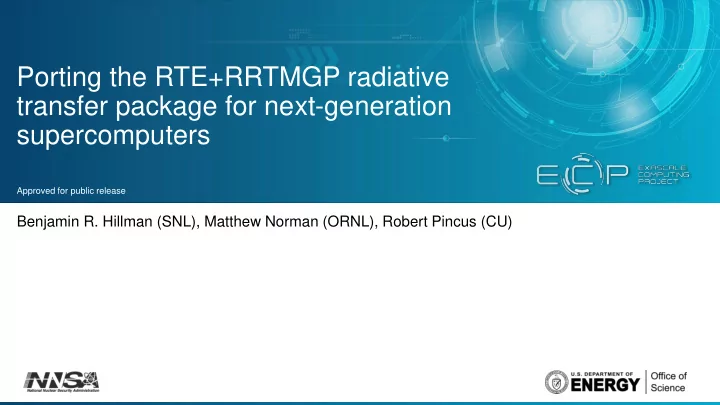

Porting the RTE+RRTMGP radiative transfer package for next-generation supercomputers Approved for public release Benjamin R. Hillman (SNL), Matthew Norman (ORNL), Robert Pincus (CU)
Two paths toward a DOE global cloud-permitting model • Simple Cloud-Resolving E3SM Atmosphere Model (SCREAM) – Rewrite our existing atmosphere in C++/kokkos for performance portable GPU support with simplified physics – Scale up to 3km resolution – Target simulations in 2021 • E3SM using the Multi-scale Modeling Framework (E3SM-MMF) – Multiscale modeling approach, “ superparameterization ” – Cloud resolving convection – Very high computational intensity – ideal for GPUs – Fortran with OpenACC for GPU support 2
E3SM-MMF Highlights • Complete port of the CRM superparameterization to GPUs – refactored 30K lines of code to enable openACC acceleration – represents about 50% of the cost of the model – Port of remaining 40% (RRTMGP package) recently completed • Summit Early Science Simulation – 1024 Summit nodes, running at 0.62 SYPD – 6 year simulation, 300K node-hours – Running a weather resolving global model (25km) with a cloud resolving 2D CRM (1km superparameterization) • Gordon Bell Submission SC2019 – 4600 Summit nodes, ~5.4PF – 1.8 SYPD with 2km resolution – 0.22 SYPD at 500m resolution 3
Radiative transfer cost • Radiative transfer is expensive: ~1/3 the cost of the atmospheric physics • CRM has already been ported to GPU on Summit: ~15x speed-up • This talk: efforts to port the radiative transfer package to GPU Relative cost of physics packages on Intel Sandy Bridge 4
Radiative transfer package: RTE+RRTMGP • Rewrite of popular RRTMG Implementation: levels of abstraction radiation package • Expose parallelism Model interface layer (translate model data types to RTE+RRTMGP data types) • Modern software practices RTE+RRTMGP user interface layer: modern Fortran (classes) Goal: port kernels for performance portability, leaving interface largely untouched Compute kernels: array-based 5
Porting RTE+RRTMGP using OpenACC • Goal: RTE+RRTMGP fully running on Summit GPU • Steps: – Expose parallelism – Wrap with OpenACC directives without explicit data management – Compile with ptxinfo flag to highlight generation of implicit data copying code – Add explicit data management to directives 6
Porting: example Tightly-nested loops (expose parallelism) Structured data statements keep data on the device 7
Testing • How do we know we have the right answer (and didn’t screw anything up)? • Need to test after each code addition! – Rapid, easy to launch regression tests • Testing framework based on RTE+RRTMGP RFMIP example code (provided in RTE+RRTMGP Git repo) – End-to-end, stand-alone test – Code: reads in example atmosphere data, computes radiative fluxes due to gaseous absorption – Test: compare outputs from a test run with outputs from a baseline (before the code modification) – Challenge: answers are not bit-for-bit due to floating point differences arising from atomic updates on the GPU (cannot guarantee order of updates) 8
Testing: example Diffs between CPU and reference: Variable rlu: No diffs Variable rld differs (max abs difference: 3.814697e-06; max frac. difference: 1.178709e-05%) Variable rsu differs (max abs difference: 3.051758e-05; max frac. difference: 1.185221e-05%) Variable rsd differs (max abs difference: 6.103516e-05; max frac. difference: 1.087066e-05%) Diffs between GPU and reference: Variable rlu: No diffs Variable rld differs (max abs difference: 1.490116e-08; max frac. difference: 1.173428e-05%) Variable rsu differs (max abs difference: 3.051758e-05; max frac. difference: 1.184619e-05%) Variable rsd differs (max abs difference: 6.103516e-05; max frac. difference: 1.087066e-05%) Diffs between CPU and GPU: Variable rlu: No diffs Variable rld differs (max abs difference: 3.814697e-06; max frac. difference: 1.178709e-05%) Variable rsu differs (max abs difference: 3.051758e-05; max frac. difference: 1.185221e-05%) Variable rsd differs (max abs difference: 3.051758e-05; max frac. difference: 9.782132e-06%) Subjectively, differences order 1e-5 are “tolerable” 9
When things go bad … Missing atomic update in reduction operation leads to wrong answers! 10
Debugging tools • Cuda-memcheck • Valgrind (on CPU) • Bounds checking (on CPU) • Simplifying data movement 11
Profiling tools • PGI_ACC_TIME=1: quick timing info for compute vs data movement • NVPROF: visual representation of profiling data – Run code on compute node, save nvprof output – View using nvvp – Useful for identifying bottlenecks and excessive data movement 12
PGI_ACC_TIME=1 example This is a high-level routine doing a lot of data movement 13
NVPROF example After explicit data movement: much less device to host transfers 14
Future directions: transition to OpenMP Offload, and managed memory • For enhanced portability, we are creating an OpenMP 4.5+ version of the code – OpenMP 4.5+ includes a kernel offload for accelerators – OpenMP4.5 and OpenACC have a nearly 1:1 correspondence • !$acc copyin() --> !$omp map(to:) • !$acc update host() --> !$omp target update(from:) • !$acc parallel loop --> !$omp target teams distribute parallel for – Deep copy issues get a little more hairy, but we plan to sidestep that • We plan to use managed memory – Automatically pages data to/from GPU (no more data statements!) – -ta=nvidia,managed for PGI for now (currently there are bugs, though) – We will replace “allocate()” with custom cudaMallocManaged() routine using the LLNL Umpire pool allocator 15
Summary and challenges • RTE+RRTMGP radiative transfer code ported to GPU using OpenACC directives • The need to minimize data movement between device and host requires adding directives pretty high up in the code – impossible to confine to kernels • A number of compiler bug work-arounds needed • Next step: evaluating performance in the full model 16
Extra slides 17
Context: Developing a cloud-permitting climate model for DOE exascale achitectures How do we parameterize this sub-grid variability? 18
Radiative transfer package: RTE+RRTMGP • Separation of concerns RTE: solvers • One-dimensional plane- RRTMGP parallel RT equations • Optical properties • Absorption/emission or • Source functions two-stream • Spectral discretization: • Adding for transport correlated k-distribution • Extensible to multi-stream methods 19
Recommend
More recommend